I Can’t See Venus!
June 2012
I looked at the sunrise on the 5th at 5am to see the Transit of Venus passing in front of the early morning sun. It was cloudy at first –so I’m not sure f I missed it

Sunrise
…..or maybe my timing was wrong, anyway I hung out of the up stairs window with binoculars to shine the image of the sun on to paper. (This was to avoid direct eye contact with the sun)
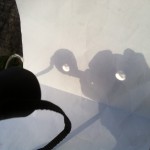

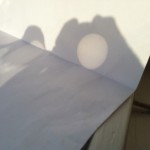
Sun image on paper through binoculars
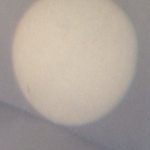
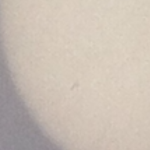
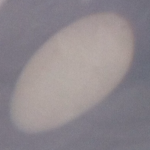

The sun enlarged from the camera picture on my phone
What do you think? Did I get the picture? Doesn’t look like it, but Chris Lockwood
definitely did catch it on his mobile phone.
http://www.jb.man.ac.uk/~slowe/transit2004/photo/chris_lockwood.jpg
Information re the Transit of Venus here:
http://thewatchers.adorraeli.com/wp-content/uploads/2012/06/planes.jpg
http://www.h2g2.com/approved_entry/A9913908
But Can You Hear Venus – Live?
For some time now I have found it interesting that it’s possible to hear rather than see objects and emissions of radiation, gas and dust you can’t see because they are a very long distance away from us in space. These waves from the electro magnetic spectrum, where light is the wave we are most familiar with, bring information to us through instruments, about the things we are unable to see. Listen to recorded sounds on this podcast from Jodrell Bank – http://www.jodrellbank.manchester.ac.uk/multimedia/audio/soundsofspace.html
I have been looking into ways of accessing live, streamed radio waves from outside the earths’ atmosphere, in fact as far away as possible, and have sought advise from experts. Please excuse any inaccuracies in terms of scientific information in this brief post!
• Advice from the BAA RAG was that it is possible to put up a loop aerial on a house in a city and solar radio bursts can be received with a commercial short wave receiver and a suitable antenna but, as with Jupiter, they would be infrequent and would not appear to order, which would make demonstrating them difficult. There are some examples here: http://www.heliotown.com/Radio_Sun_Introduction.html
The advice was that I would be limited to what is available from the internet from professional observatories, e.g. http://soi.stanford.edu/results/sounds.html
• Advice from Jodrell Bank is that they do use live data in their research projects, but the sonification of that data is not the system currently and would be an extra project they couldn’t take on at the moment. They suggested I could more easily set up a TV with VHF receiver to get the live ‘crackle’ or white noise in between channels, 1% of which, unbelievably, is the microwave background emission from the Big Bang.
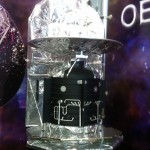 http://herschel.cf.ac.uk/ and from Manchester University working with the ALMA array of telescopes in Chile - http://sse.royalsociety.org/2012/exhibits/alma-observatory/. These are finishing and starting projects respectively that don’t have streamed data for the public.
http://herschel.cf.ac.uk/ and from Manchester University working with the ALMA array of telescopes in Chile - http://sse.royalsociety.org/2012/exhibits/alma-observatory/. These are finishing and starting projects respectively that don’t have streamed data for the public.
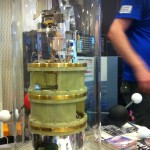
From the ALMA project -a band receiver
• Radio Jove, produced by NASA, shows how you can pick up sounds yourself and what you need. http://radiojove.gsfc.nasa.gov/
• There is a big research project at Leeds University researching into Cosmic Rays – http://www.ast.leeds.ac.uk/research/uhe-cr.html and a lively contingent were helping from The Langton Star Centre at Simon Langton School that I met at the RSS Exhibition as well. http://www.thelangtonstarcentre.org/ . It was thought live streaming of Cosmic Ray data might be possible.
At the Royal Society Summer Exhibition I was able to see a Cloud Chamber or Scintillator in action for myself, which showed up evidence of the radiation raining down on us: Muons whose live trails were clear to see constantly appearing and dying.
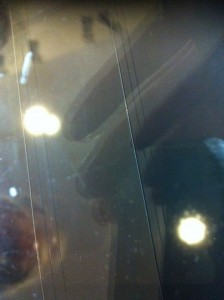
Cloud Chamber or Scintilator
Here also is a video and an explanation of the cloud chamber. http://www.cosmicray.com/ Scroll down page and click on video entitled ‘large diffusion cloud chamber’.
Victor Hess discovered Cosmic Rays in 1912, by measuring the level of ionising radiation in the atmosphere and found that it increased with altitude. He concluded that the radiation was non-terrestrial in origin.
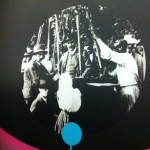
Victor Hess 1912 – in hot air balloon
Here are some interesting artists I have come across recently who are concerned with sound/signals/ data streams – out side earths’ atmosphere and well worth looking up:
• Honor Harger is giving a talk here at LIFT on ‘The Sounds of Space’. http://videos.liftconference.com/video/1178813/honor-harger-listening-to-the
• Brian Duffy made work called the Otophonic Lunaphone 2004, where he created telescopes that sonified the light from stars. Listen here –
http://www.youtube.com/watch?v=W3z2CuynH2U . More recently he has worked at Jodrell Bank on a work Silsils:Infinite Qawwali –
http://www.asiatriennialmanchester.com/whats-on/event/silsila-infinite-qawwali/
• Robin McGinnley describes here – The Earth’s Original 4.5 Billion Year Old Electronic Music Composition (A Work in Progress). I heard him talk at the Supersonix 2012 conference about his sound piece – Cosmic Radio Phone. http://www.interactive-agents.com/frontpage3.html
• Steven P. McGreevy. Here is a site with sounds from the Magnetosphere – A 19-minute duration MP3 audio presentation of VLF recordings to Festival Sonika in Madrid, Spain – 08 Dec. 2011 (26.2 MB – 192 kbps PODCAST MP3)
• McGreevy also took a near perfect picture of Venus crossing the sun on 6th June – the picture I didn’t get. Scroll down the page to find it. The original is here – http://www.auroralchorus.com/
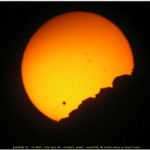
Photo Steve P. McGreevy. Venus transit –Keeler California 6th June 2012
End